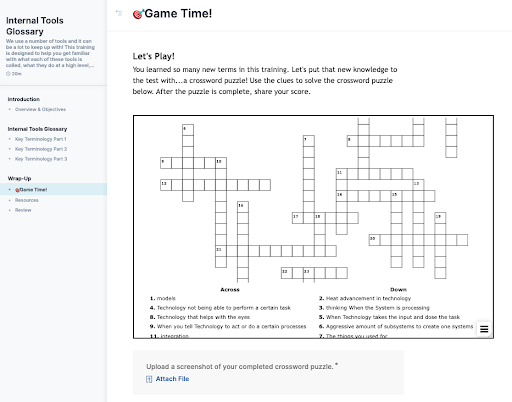More Doing, Less Telling: Creative Ways to Build Engagement in Training Workshops and Courses
admin
Learning Tips Straight to Your Inbox
Turn static learning into a dynamic experience, whether running a workshop in person or online.
In our recent webinar, WorkRamp’s Manager of Instructional Design, Jen Scopo, and Sr. Instructional Designer, Jess Arias, shared insightful and easy ways you can make learning engaging.
“We’re giving you actual tactics that you can grab onto and can implement into your training immediately, regardless of how experienced you may or may not be in building your own training content and designing training programs.” – Jen Scopo
Continue reading to learn:
- Ways to leverage unique methods of delivering information in-person and online
- How to create engaging activities to keep learners focused and enhance their learning experience
- Methods to incorporate real-world opportunities for applied learning
In this post:
Make sure your course delivery is dynamic
You can have the most dynamic and impactful course content, but if you don’t deliver it the same way, you will struggle to keep the group engaged and lose the impact.
Training must start on a high note and capture the group immediately. The best way to get the group’s attention right away is to ensure your introduction builds momentum. Here are a few ideas to start dynamically:
- Ask a fundamental question like “how many of you ______”. Questions that relate to the topic can capture everyone’s attention.
- Clearly explain the “What’s In It For Me” (WIIFM). This will allow the group to know how the information to be shared will help them in the long run.
- Set basic expectations. Let them know their role expectations during the training session and how the workshop will be conducted. This way, they know what to expect, and you have set the stage for what’s to come.
- Outline the tangible learning outcomes. Like setting expectations, outlining the learnings the group should walk away with can help them focus and mentally figure out how they will implement the learnings as they go through the workshop.
- End the introduction by asking a follow-up question. Ask the question, “Sound good to everyone?” to ensure you still have full engagement and that everyone is on the same page.
Now that you have effectively engaged your group, ensure that how you’re delivering your content is dynamic. Of course, you will likely have lecture elements, basic visuals, etc. Lean into these tactics; however, to provide your core content differently, give one of the following ideas a try:
- Case Study Exercises
- Call Recordings and Role Plays
- “Front-of-Room” Demos
- Subject Matter Expert (SME) Panels
- Group Brainstorming
- Group Teachbacks
- Gamification
Each of the tactics above provides a new way to get the group involved in the content, encourage higher levels of thinking and analyzing, and help keep them focused.
Bring Your Training Content to Life
There is a lot of information to digest during training courses. To help the learner retain all the knowledge you share, create ways to bring it to life. Essentially, ways to be more interactive with the group.
Knowledge Checks
Knowledge checks and learning exercises don’t just have to be quizzes at the end of training. Using these throughout your training can create opportunities for learners to engage with content as it’s being learned.
Review core content: You don’t say something once and move on in a live training environment. A skilled facilitator will present the same information in a few different ways to make sure it sticks. You can do the same thing using knowledge checks in a self-paced course.
Applied learning: This is where more doing, less telling, comes into play. Learners retain about 10 percent of what they’re told, and when they get the opportunity to practice the information said to them, it sticks.
To help the learner retain information, add a question like, “Explain the concept that you just learned as if you were teaching a colleague” or “What’s your TL/DR version of what you just learned”.
It can even be more involved at the end of a course like, record yourself delivering a pitch to a client.
Maximize your ROE (Return on Effort): Ultimately, the goal of any training is for the people who take it to learn something. Adding knowledge checks throughout your courses — this goes for live sessions, too — will ensure that you get the most out of your effort into creating that content. This will also help you understand if the group understands the information early instead of after the workshop.
Virtual Engagement
In a world where so many of us work remotely, it takes extra effort to build in the social interaction that may have happened organically in an in-person environment. But there are ways to do it.
Collaborate: Most web meeting applications have some chat built-in. Encourage students to share experiences, comment on what’s being presented, ask questions, brainstorm. You can allow this throughout your training or carve out a specific time, and it’s low pressure and can help create a fun learning environment.
Get insights: You can use Polls to give learners a chance to express their opinion about something or share previous experiences. This gives them another way to use their voice and gives you insight into your audience.
Be social: An easy tactic to use in any training, particularly in new hire training, is to create a Slack thread or whatever communications tool you use. When learning about company values on the first day of onboarding, ask them to post something interesting to that Slack thread, and then ask them to find a comment posted in that thread and respond.
Or use LinkedIn to do the same thing. Ask new employees (if they’re comfortable) to share a post on LinkedIn about their first day and have them tag the company and a peer that they want to give a shoutout to.
Acting Out
This is the true meaning of “bringing your content to life”! Adding in opportunities to act is a great way to liven up the environment.
Get creative: Give learners a chance to step outside of a typical learning environment and use their creative brains. Ask participants to role-play scenarios that use props, characters, or humor. For example, if learners just completed a product training, task them with putting together a two-minute Ted Talk or a breaking-news segment about a groundbreaking new technology (the product).
Level-up learning: You can use a similar approach to take learning to the next level. Present something that you should NOT do.
Say that they learned how to deliver the perfect sales pitch. Ask learners to role-play the worst version of a sales pitch doing the opposite of everything they discovered. This will demonstrate that they understand what good looks like enough to flip it on its head, solidifying what not to do.
Applied learning: The great thing about encouraging learners to “act out” is a built-in way to help retain knowledge. You can read a million books about riding a bike, but until you practice pedaling, it won’t happen.
Gamification
Gamification is one of the best ways to get your group involved, and it doesn’t have to cost you a new gaming platform. Here are some easy ways to do this:
Be creative: Use real-life games to get your learners involved. You might’ve seen Mythbusters on Netflix. Tell your learners a statement or scenario or “fact.” Then they have to prove or disprove it and explain their process.
Another example, you can build a crossword puzzle with terminology/concepts that suit your content.

Create a free crossword puzzle at crosswordlabs.com. Then, embed it to the end of a WorkRamp guide as a fun way for learners to test their knowledge.
Level-up learning: Games force you to take the content you’ve learned and look at it differently to achieve a goal. This increases the learner’s ability to think critically because they take the concepts they learned and apply them in a different context.
Applied learning: Games are a great way to keep your audience engaged. When the learning experience is positive, people will want to return for more.
Wrap up: Take Action
Help your learners take control of their learning. Bring your participants into the experience with at least one of the above creative ideas to impact the group’s learning experience.
And, when your course comes to an end, ask those who participated for feedback. This will help you understand what the group enjoyed and how you can improve for the next workshop or course.
For more tips on creative ways to build engagement in training workshops and courses, check out the entire webinar with our Instructional Design team members.
Need help planning your workshop or course? Contact us for a free 30-minute consultation. If you’re an existing WorkRamp customer, contact your Account Manager. Otherwise, send us an email: instructional-design@workramp.com.
Complete the form for a custom demo.
Recent Posts
- WorkRamp Launches AI Practice to Revolutionize Sales Enablement July 22, 2024
- How to Recognize Employee Burnout July 17, 2024
- What is the Best SCORM-compliant LMS? July 10, 2024
- How to Make a Training Module For Online Learning (2024 Guide) July 1, 2024
- The Role of Emotional Intelligence in Sales Enablement June 28, 2024
admin
You might also like
3 reasons learning will propel your business forward
When you invest in talent, your team becomes unstoppable. Discover how learning is a growth engine to boost business impact and retain talent.
Read More
How you can put L&D front and center at your company
Effective learning and development (L&D) programs are a great way to stand out as a brand to attract skilled talent and keep current employees happy and engaged.
Read More
Announcing 2022 Spring Release Features in WorkRamp
WorkRamp launches automated workflows, new compliance features, and other academies features to enhance the admin and user experience on the platform.
Read More
Decrease Ramp Time and Increase Revenue
Get in touch to learn how WorkRamp can help you achieve your enablement goals.
Request a Demo



